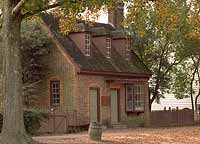Page content
Mary Stith House
- Daughter of president of College of William & Mary
- 1813 will bequeathed property to African American servants
- Interpretive programs take place in restored building today

Charming one-story brick building on Duke of Gloucester Street
A small, reconstructed building on Duke of Gloucester Street, the Mary Stith Shop is a one-story brick structure with a bay window and three dormers, and a charming, almost dollhouse appearance. Here visitors might encounter a Colonial Williamsburg character interpreter – Martha Washington, Mary Stith herself, various ladies of the town, the gentlemen's gentlemen, etc. Interpretive programs at the Mary Stith House vary from week to week.
Mary Stith lived to see independence and the establishment of the Republic. She wrote her will in 1813. Among its beneficiaries were her African American servants, to whom she left her shop. Her will shows her depth of feeling for them:
"All the coloured people in my family being born my slaves, but now liberated, I think it my duty not to leave them destitute nor to leave them unrecompensed for past services rendered to me. As in the cause of humanity I can do but little for so many, and that little my conscience requires me to do, therefore I subject the whole of my estate to the payment of my just debts, and to the provision which I herein make for them."
Will left most property to freed black servants
With the exception of few small legacies to white friends, Stith left most of her considerable estate, including three buildings and the ground on which they stood, to her freedmen. To Jenny, "the mother of the family," she left her dwelling house and lot, some furniture, clothing, and £100, as well as £5 a year for each of her two granddaughters, Jenny and Patty Gillett. These two jointly received the second building on Stith's town lot, which she described as "my house in the yard called the tin shop." Each of them also received clothing, items of furniture, and £25. The third structure Stith bequeathed to Nelly Bolling and "her two sisters Eve and Sally." This building she described as "my house on the main street called Woods shop." Each of these three women also received cash legacies, as did Peter Gillett, Benjamin White, Beverley Rowsay, Rachel White, and Fanny White.
